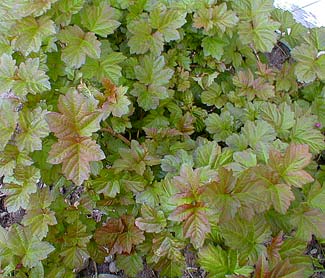 Dwarf European Cranberry Bush
Dwarf European Cranberry Bush
Viburnum opulus 'Nanum', the Dwarf European Cranberry Bush, originated in France in 1841, a cultivar rarely offered in our local nurseries. It's only marginal popularity is likely due to the fact that it scarsely ever develops the white flowers, let alone cranberries, which are so abundant on the original V. opulus. Some specimens are known to flower a little, but ours in four years never did so to the least degree.
I didn't know when I obtained it that it was all but invariably unflowering, or I might not have brought it home, & would probably be just as happy to give it away to any visiting pal who didn't feel too awfully that I was merely foisting off an inferior plant on them.
Still, I remember when I bought it, how extremely pretty I found its leaves to be, & occasionally since, when it is showing itself at its best in spring, I regain my initial fondness for it. When I bought it, it was because the small stature meant I could put it alongside a garden step-down without worrying about it overgrowing the stone step. It served that purpose for two years, though being a slope, the drainage was a bit sharp for a shrub that seemed to want persistant moistness, so that it was a bit stressed & attracted black aphids.
Eventually I replaced it with a dwarf species-rhody that does bloom nicely, & moved the dwarf viburnum to a spot near the foot of a tall King Edward III currant. It did well through spring, as shown in the spring photo above. But come summer, again the sharp drainage of the location meant it was occasionally even dryer than in its former spot. Even with fairly regular watering, the swiftness with which the soil dried caused the dwarf shrub to be stressed, & suffered leaf-browning in strong afternoon sun.
A bit exasperated with it, I moved it to a third location, half-hidden in a shady spot along a drip hose. As it is potentially susceptible to root-rot if overwatered, I hope I'm not now overdoing it in the other direction by shifting it to a moist area. The species per se, if it were located in such a shady spot, wouldn't flower very well; but for this non-flowering sport, that's not an issue, so my fingers are crossed for it.
I feel a little sorry for it, having gotten shuffled about like an unwanted bastard child. If it fails to flourish in this last location, I will finally give up on it & it's off to the compost pile. If it does do well, as I think it will now that it need never again experience droughtiness, it'll remain partially hidden by clumping perennials & woody shrubs of greater interest, serving exclusively as a low-growing leafy fill-in, with a pleasant-enough twiggy presence in winter when the perennials have died back.
As a little specimen shrub in highly visible locations, it always failed. As a minor fill-in, I really hope it's at long last going to fulfill a purpose. I'll have to update this page again, in 2004, when I know for sure how it likes this final location.
Despite not fruiting & flowering it can be an interesting deciduous shrub, small & mounded, much more densely leafed than the majority of viburnums, only occasionally exceeding two feet of height by two foot spread. It provides a small spot of maple-like leaves, from a species that in its non-dwarf forms is large hence impossible to slip in just anywhere.
The smallness & the density of its maple leaves provide its chief appeal. These leaves emerge reddish but are soon green & remain green well into Autumn unless summer heat stresses it too much. Late in Autumn the leaves turn a disinteresting rusty color before dropping, leaving a tight network of pleasant twigs that turn red & orange for winter.
Though susceptible to aphids & sensitive to drought, it ought otherwise to be hardy & reliable, & my mediocre luck with it has likely been due to my having assumed it would be as fully adaptable as the species overall, & not keeping it moist enough. It requires persistently moist well-drained soil, & oughtn't complain whether it finds itself in a cold, hot, or temperate zone.
It prefers a lot of sun, but tolerates a bit of shade better than it tolerates dryness. It requires little or no pruning ever, though if one does bother to prune it back late in the winter, it'll re-emerge with more of the rosy flush on its young leaves. It likes the Northwest's acid soil, but reportedly has no particular soil preference & would do well even in clayey soils or in limestone-derived soils.